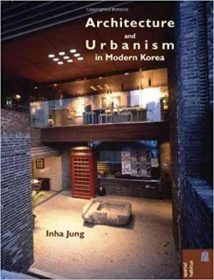نام کتاب: Architecture And Urbanism In Modern Korea
نویسنده: Jung Inha
ویرایش: ۱
سال انتشار: ۲۰۱۴
کد ISBN کتاب: ۹۷۸۰۸۲۴۸۳۵۸۵۹, ۹۷۸۹۸۸۸۲۰۸۰۲۹, ۰۸۲۴۸۳۵۸۵۹,
فرمت: PDF
تعداد صفحه: ۲۰۹
حجم کتاب: ۹ مگابایت
کیفیت کتاب: OCR
انتشارات: University Of Hawaii Press
Description About Book Architecture And Urbanism In Modern Korea From Amazon
Although modernization in Korea started more than a century later than in the West, it has worked as a prominent ideology throughout the past century―in particular it has brought radical changes in Korean architecture and cities. Traditional structures and ways of life have been thoroughly uprooted in modernity’s continuous negation of the past. This book presents a comprehensive overview of architectural development and urbanization in Korea within the broad framework of modernization.
Twentieth-century Korean architecture and cities form three distinctive periods. The first, defined as colonial modern, occurred between the early twentieth century and 1945, when Western civilization was transplanted to Korea via Japan, and a modern way of life, albeit distorted, began taking shape. The second is the so-called developmental dictatorship period. Between 1961 and 1988, the explosive growth of urban populations resulted in large-scale construction booms, and architects delved into modern identity through the locality of traditional architecture. The last period began in the mid-1990s and may be defined as one of modernization settlement and a transition to globalization. With city populations leveling out, urbanization and architecture came to be viewed from new perspectives.
Inha Jung, however, contends that what is more significant is the identification of elements that have remained unchanged. Jung identifies continuities that have been formed by long-standing relationships between humans and their built environment and, despite rapid modernization, are still deeply rooted in the Korean way of life. For this reason, in the twentieth century, regionalism exerted a great influence on Korean architects. Various architectural and urban principles that Koreans developed over a long period while adapting to the natural environment have provided important foundations for architects’ works. By exploring these sources, this carefully researched and amply illustrated book makes an original contribution to defining modern identity in Korea’s architecture, housing, and urbanism.
درباره کتاب Architecture And Urbanism In Modern Korea ترجمه شده از گوگل
گرچه نوسازی در کره بیش از یک قرن دیرتر از غرب آغاز شده است ، اما در طول قرن گذشته به عنوان یک ایدئولوژی برجسته عمل کرده است – به ویژه تغییرات اساسی در معماری و شهرهای کره ایجاد کرده است. ساختارهای سنتی و شیوه های زندگی در نفی مداوم مدرنیته از گذشته کاملاً ریشه کن شده است. این کتاب مروری جامع بر توسعه معماری و شهرنشینی در کره در چارچوب گسترده مدرنیزاسیون دارد.
معماری و شهرهای کره ای قرن بیستم سه دوره متمایز را تشکیل می دهند. اولین مورد ، که به عنوان مدرن استعماری تعریف می شود ، بین اوایل قرن بیستم و ۱۹۴۵ اتفاق افتاد ، زمانی که تمدن غرب از طریق ژاپن به کره پیوند شد و یک سبک زندگی مدرن ، البته تحریف شده ، شکل گرفت. دوم دوره به اصطلاح دیکتاتوری توسعه است. بین سالهای ۱۹۶۱ و ۱۹۸۸ ، رشد انفجاری جمعیتهای شهری منجر به رونق ساخت وسازهای گسترده ای شد و معماران از طریق محل معماری سنتی به هویت مدرن پرداختند. آخرین دوره از اواسط دهه ۱۹۹۰ آغاز شد و ممکن است به عنوان حل و فصل مدرنیزاسیون و گذار به جهانی شدن تعریف شود. با تسطیح جمعیت شهرها ، از منظرهای جدید به شهرنشینی و معماری پرداخته شد.
اما اینها یونگ ادعا می کند آنچه مهمتر است شناسایی عناصری است که بدون تغییر مانده اند. یونگ تداوم هایی را مشخص می کند که در اثر روابط طولانی مدت بین انسان ها و محیط ساخته شده آنها شکل گرفته و علی رغم مدرنیزاسیون سریع ، هنوز ریشه عمیق در سبک زندگی کره ای دارد. به همین دلیل ، در قرن بیستم ، منطقه گرایی تأثیر زیادی بر معماران کره ای گذاشت. اصول مختلف معماری و شهری که کره ای ها در طول مدت طولانی با سازگاری با محیط طبیعی ایجاد کردند ، مبانی مهمی برای آثار معماران فراهم کرده است. با کاوش در این منابع ، این کتاب با دقت تحقیق و نشان داده شده سهم اصلی در تعریف هویت مدرن در معماری ، مسکن و شهرسازی کره دارد.
[box type=”info”]![]() جهت دسترسی به توضیحات این کتاب در Amazon اینجا کلیک کنید.
جهت دسترسی به توضیحات این کتاب در Amazon اینجا کلیک کنید.![]() در صورت خراب بودن لینک کتاب، در قسمت نظرات همین مطلب گزارش دهید.
در صورت خراب بودن لینک کتاب، در قسمت نظرات همین مطلب گزارش دهید.

